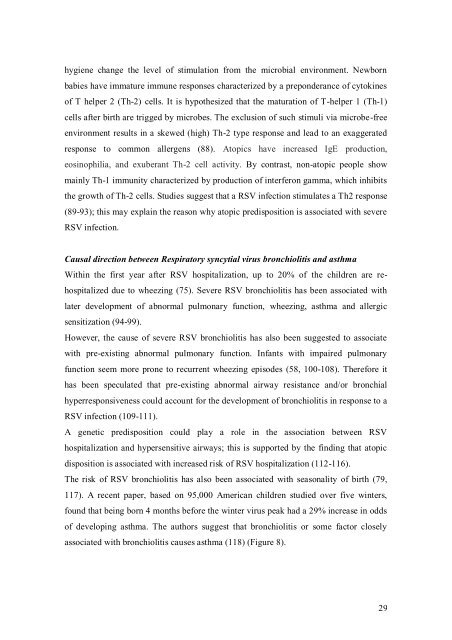Lung function measurements in children - copsac
Lung function measurements in children - copsac
Lung function measurements in children - copsac
You also want an ePaper? Increase the reach of your titles
YUMPU automatically turns print PDFs into web optimized ePapers that Google loves.
hygiene change the level of stimulation from the microbial environment. Newborn<br />
babies have immature immune responses characterized by a preponderance of cytok<strong>in</strong>es<br />
of T helper 2 (Th-2) cells. It is hypothesized that the maturation of T-helper 1 (Th-1)<br />
cells after birth are trigged by microbes. The exclusion of such stimuli via microbe-free<br />
environment results <strong>in</strong> a skewed (high) Th-2 type response and lead to an exaggerated<br />
response to common allergens (88). Atopics have <strong>in</strong>creased IgE production,<br />
eos<strong>in</strong>ophilia, and exuberant Th-2 cell activity. By contrast, non-atopic people show<br />
ma<strong>in</strong>ly Th-1 immunity characterized by production of <strong>in</strong>terferon gamma, which <strong>in</strong>hibits<br />
the growth of Th-2 cells. Studies suggest that a RSV <strong>in</strong>fection stimulates a Th2 response<br />
(89-93); this may expla<strong>in</strong> the reason why atopic predisposition is associated with severe<br />
RSV <strong>in</strong>fection.<br />
Causal direction between Respiratory syncytial virus bronchiolitis and asthma<br />
With<strong>in</strong> the first year after RSV hospitalization, up to 20% of the <strong>children</strong> are rehospitalized<br />
due to wheez<strong>in</strong>g (75). Severe RSV bronchiolitis has been associated with<br />
later development of abnormal pulmonary <strong>function</strong>, wheez<strong>in</strong>g, asthma and allergic<br />
sensitization (94-99).<br />
However, the cause of severe RSV bronchiolitis has also been suggested to associate<br />
with pre-exist<strong>in</strong>g abnormal pulmonary <strong>function</strong>. Infants with impaired pulmonary<br />
<strong>function</strong> seem more prone to recurrent wheez<strong>in</strong>g episodes (58, 100-108). Therefore it<br />
has been speculated that pre-exist<strong>in</strong>g abnormal airway resistance and/or bronchial<br />
hyperresponsiveness could account for the development of bronchiolitis <strong>in</strong> response to a<br />
RSV <strong>in</strong>fection (109-111).<br />
A genetic predisposition could play a role <strong>in</strong> the association between RSV<br />
hospitalization and hypersensitive airways; this is supported by the f<strong>in</strong>d<strong>in</strong>g that atopic<br />
disposition is associated with <strong>in</strong>creased risk of RSV hospitalization (112-116).<br />
The risk of RSV bronchiolitis has also been associated with seasonality of birth (79,<br />
117). A recent paper, based on 95,000 American <strong>children</strong> studied over five w<strong>in</strong>ters,<br />
found that be<strong>in</strong>g born 4 months before the w<strong>in</strong>ter virus peak had a 29% <strong>in</strong>crease <strong>in</strong> odds<br />
of develop<strong>in</strong>g asthma. The authors suggest that bronchiolitis or some factor closely<br />
associated with bronchiolitis causes asthma (118) (Figure 8).<br />
29






